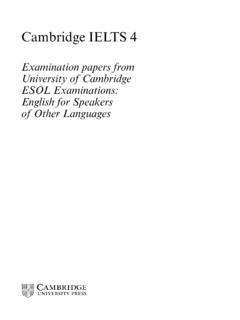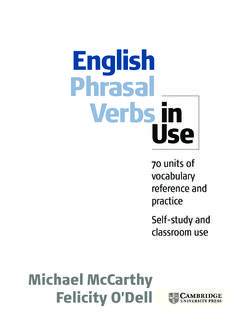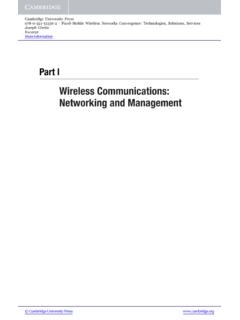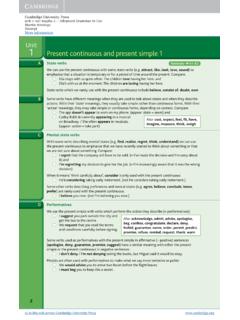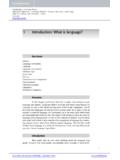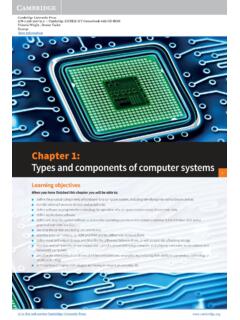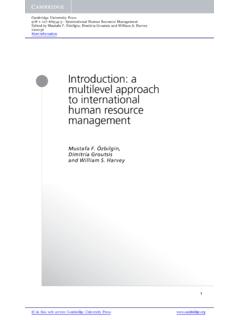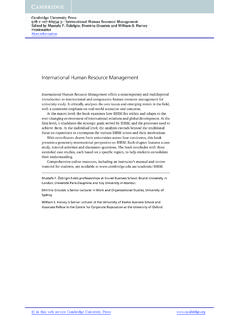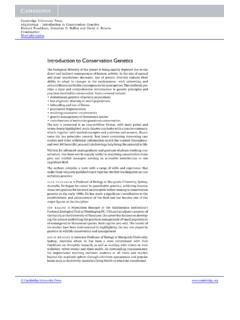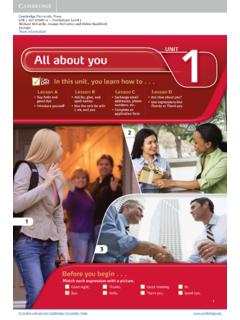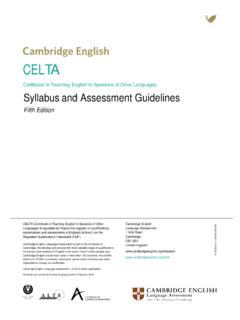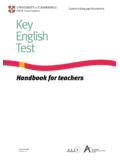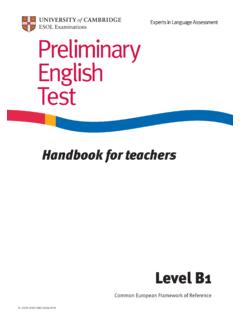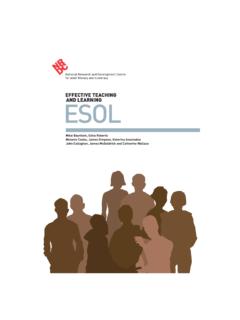Transcription of Cambridge Preliminary English Test 3
1 CambridgePreliminary English Test3 TEACHER S BOOKE xamination papers from University of Cambridge ESOL Examinations: English for Speakers ofOther LanguagesPUBLISHED BY THE PRESS SYNDICATE OF THE UNIVERSITY OF CAMBRIDGEThe Pitt Building, Trumpington Street, Cambridge , United KingdomCAMBRIDGE UNIVERSITY PRESSThe Edinburgh Building, Cambridge CB2 2RU, UK40 West 20th Street, New York, NY 10011 4211, USA477 Williamstown Road, Port Melbourne, VIC 3207, AustraliaRuiz de Alarc n 13, 28014 Madrid, SpainDock House, The Waterfront, Cape Town 8001, South Cambridge University Press 2003 This book is in copyright. Subject to statutory exceptionand to the provisions of relevant collective licensing agreements,no reproduction of any part may take place withoutthe written permission of Cambridge University published 2001 New edition published 2003 Printed in the United Kingdom at the University Press, CambridgeTypefaceHelvetica 10/13pt.
2 SystemQuarkXPress [OD&I]A catalogue record for this book is available from the British LibraryISBN 0 521 75472 0 Student s BookISBN 0 521 75473 9 Student s Book with answersISBN 0 521 75474 7 Teacher s BookISBN 0 521 75475 5 Set of 2 CassettesISBN 0 521 75476 3 Set of 2 Audio CDsISBN 0 521 75477 1 Self-study PackContentsIntroduction5 PET content and marking10 Paper 1: Reading and Writing10 Paper 2: Listening15 Paper 3: Speaking16 Grading, awards and results20 Frames for the Speaking test22 Test 1 KeyPaper 131 Paper 239 Transcript39 Test 2 KeyPaper 145 Paper 254 Transcript54 Test 3 KeyPaper 160 Paper 269 Transcript69 Test 4 KeyPaper 175 Paper 283 Transcript835 IntroductionThe background to the update of PETThe Preliminary English Test (PET) was originally introduced in response to a demandfor an examination at a lower level than that of the First Certificate in English and onewhich would be at the Council of Europe Threshold level, as defined by van Ek standard practice in Cambridge ESOL, examinations are periodically reviewed aspart of the examination production process, to ensure that they remain fair, up-to-dateand in line with customer expectations.
3 The PET examination was last revised in part of the detailed and comprehensive review of the Preliminary English Testwhich began in 1999, stakeholders were canvassed for opinions on the , students, Local Secretaries and Senior Team Leaders provided CambridgeESOL with valuable feedback about all aspects of PET. Cambridge ESOL receivedvery encouraging responses from stakeholders around the world, and as aconsequence the changes included in the updated tests are minimal. The updatedexamination in the format in this test book begins in March 2004. All new materialshave been extensively trialled and, as before, all materials that go into the live questionpapers have been pretested to ensure that they are suitable for the PET candidatureand, in terms of difficulty, are at the appropriate following summarises the changes to the PET Reading/Writing Reading Part 1 (signs and notices) is three-option multiple-choice (instead of four-option) and samples a wider range of type of notice, to include short personalmessages (such as emails and post-it messages).
4 In Writing Part 1, students are given the beginning and end of the sentence for theirsentence transformation task. This focuses the task solely onto the correctidentification of the target structure. Writing Part 2 is a guided writing task with a strong communicative purpose. In Writing Part 3 (extended writing), there will be a choice of task to reflect the typesof writing that PET-level students are producing in the Listening Parts 1 and 2 are now three-option multiple-choice (instead of four-option).PET Speaking Part 1 is more Interlocutor-led, but still focuses on the same area of review process leading to the update of PET has been carefully considered and allnew task types have been thoroughly trialled to ensure that the materials are relevantand fair to PET level of PETC ambridge ESOL has developed a series of examinations which equate to the Councilof Europe Common European Framework language levels.
5 Within the levels, thePreliminary English Test is at Cambridge Level Two. This corresponds to the Councilof Europe Level B1. This is shown in the chart 5C2 (Mastery) Cambridge / ALTE LEVELSCOUNCIL OF EUROPE LEVELSCAEL evel 4C1 (Effective proficiency)FCEL evel 3B2 VantagePETL evel 2B1 ThresholdKET &Level 1A2 WaystageFlyersMovers A1 (BreakStartersthrough)In the chart, the Main Suite examinations are shown in capitals (KET, PET, FCE,CAE and CPE) and the Young Learner examinations in ESOL is a member of the Association of language Testers in Europe(ALTE). The members are all providers of examinations in European languages, andone of their principal objectives is to establish a framework of levels of proficiency inorder to promote the transnational recognition of is based on the Council of Europe s Threshold document. This represents anintermediate level of language ability that should be attainable in about 375 hoursaccording to materials a Threshold user can deal withThe text types that can be handled by the learner at this level include street signs andpublic notices, product packaging, brochures, city guides and instructions on how to dothings, as well as informal letters and newspaper and magazine texts, such as articles,features and weather forecasts.
6 The kinds of listening texts the learner needs tounderstand are announcements made at railway stations and airports, trafficinformation given on the radio, public announcements made at sporting events or popconcerts and instructions given by police or customs officials. At Threshold level,Introduction7candidates need to be able not only to pick out facts, but also to understand opinions,attitudes, moods and a Threshold user can doLearners at this level, if travelling as tourists, can get all the information needed from atourist information centre, as long as it is of a straightforward, non-specialised , if taking part in a guided tour, they can understand the main points of acommentary and ask questions in order to get more information, as long as nospecialised technical language is needed. They can deal with most situations likely toarise when making travel arrangements through a travel agent or when actuallytravelling.
7 In the context of work they can state requirements within their own job area,and ask questions of a fact-finding nature. In a meeting, they can take part in adiscussion which involves the exchange of factual information or receiving instructions,but they may have difficulty dealing with anything unpredictable or unfamiliar. Wheretelephone calls are concerned, predictability is also important at this level, and as longas only routine matters are involved, the learner can receive and pass on can write simple personal letters within a more or less standard for PETS ince PET is designed to test candidates ability to perform language tasks similar tothose required for successful performance in real life situations, practice in usingEnglish in realistic situations is the best way to prepare for is best done by giving students a wide variety of reading materials,including simple articles, reports, reviews, descriptions and narratives, particularly thetype of English that is used in everyday life advertisements, instructions and should include extensive reading of texts as well as intensive reading.
8 Togive practice in skimming and scanning skills in order to understand the generalmeaning of a text or to look for specific information. For this, simplified readers areuseful, also English language magazines in class libraries. Students should beencouraged to read widely about anything that interests should be given in short, controlled writing tasks, where the writing is for aspecific, realistic purpose, for example replies to letters, advertisements or invitations,diary entries, filling in forms, writing messages, including phone messages, writingshort notes and letters to friends. Keeping a diary in English and writing to pen-friendsare particularly useful forms of practice for is a very important skill which requires regular practice. Letter-writinglayout is not tested, but candidates are expected to recognise and use appropriatesalutations and endings. Letters to a friend relating to past experiences, presentactivities and future plans are likely to provide helpful is just as important to attend to meaning as it is to attend to forms of language .
9 Inthe exam, errors which do not hinder communication are not penalised as heavily aserrors which cause a breakdown in should be encouraged to listen to as many different sources of English asthey can, for example, films, television, radio and airport announcements; they mayalso be able to hear English spoken in hotels, shops, restaurants, at the BritishCouncil, by tourist guides, etc. Listening to native speakers or fairly fluent non-nativespeakers is the best practice they can can also collect recordings of short talks and conversations as well asusing published language -teaching cassettes and videos. When devising practicematerial, teachers should remember that candidates will not normally be required torecall particular words used, but rather to understand and remember the meaning of alistening should practise eliciting and giving simple information about themselves, forexample their name and its spelling, where they live, what they do, their interests, likesand would be very helpful for students to do this by spending time regularly talking to afriend in English about what they have been doing and about their plans, class, simple role-plays can provide an opportunity for spontaneous speech, but itis important that students are able to recognise and relate to the roles and that theyare given a specific.
10 Purposeful should always be encouraged to give reasons to justify the opinions orviews they put candidatesInformation is collected about the PET candidates at each session of the examinationwhen candidates complete a Candidate Information 2002, there were approximately 100,000 candidates for PET throughout theworld. The candidates for PET come from a wide range of backgrounds and take theexamination for a number of different reasons. The candidate profile for PET in termsof age, educational background and employment/studies varies according togeophysical regions. The design of questions in PET takes into account the potentialdiversity of age and linguistic/cultural background of candidates. The following pointssummarise the characteristics of the current PET candidature:NationalityPET is taken by candidates in more than 80 countries. The majority of thesecandidates enter for PET in European and South American countries.
